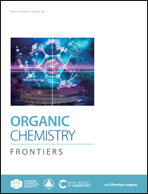Practical synthesis and divergent optimization of halichonine B for the discovery of novel pharmaceutical leads†
Abstract
The drimane sesquiterpene alkaloid halichonine B was isolated more than a decade ago, while only a very limited structure–activity relationship (SAR) was achieved in chemicobiology due to tedious synthesis (>10 steps) and inefficient modular derivatizations. Herein, a practical synthesis and divergent optimization of halichonine B is presented using the commercially inexpensive (+)-sclareolide, aiming at advancing chemicobiological exploration. Step-economic access (3 steps) to the core scaffold drimanyl amine was conceived and realized through an intramolecular Hofmann rearrangement, enabling a 6-step facile preparation of halichonine B. First agrochemical potential of this natural product and analogs was disclosed, facilitated by function-oriented rapid and modular diversifications including alkylated amines, amides, sulfamides, thioureas, and ureas. The unnatural mimic 10 and analog 12d were more effective against the cancer cell line HepG2 than cisplatin. The analog 12d was projected as a novel antifungal lead demonstrating >25-fold improvement than halichonine B against Rhizoctonia solani. Molecular docking differentiates halichonine B and the analog 12d by their interaction with the predictive target.



 Please wait while we load your content...
Please wait while we load your content...